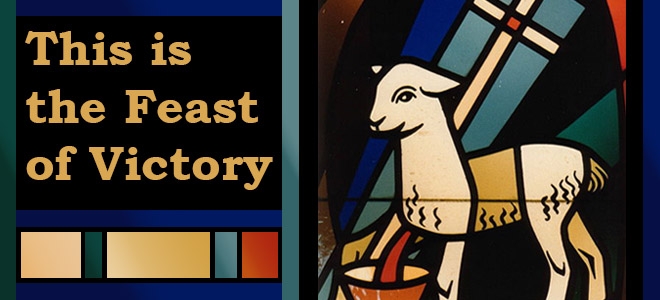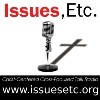Easter is all about victory: God’s victory, in Jesus Christ, over sin, death, and the power of the devil, for you. God’s Old Testament people celebrated and partook of God’s delivering them from slavery to the Egyptians in the feast of Passover (Exodus 12:1-28, 43-51; 13:3-16), which feast also pointed forward to God’s delivering His New Testament people and to their celebrating and partaking of God’s delivering them from slavery to sin in the Lord’s Supper (see, for example, 1 Corinthians 10:1-22). The Lord’s Supper on the night Jesus was betrayed, on Easter, on every Sunday of the Easter Season, and, to some extent, also on every other Sunday of the Church year truly is “the feast of victory” for all who believe in Jesus Christ.
Jesus Christ is the spotless Lamb of God (Agnus Dei in Latin), Who takes away the sin of the world (John 1:29, 36). He died on the cross, where His blood poured from His pierced side (John 19:34-36), but He also rose from the dead, and so we see Him as a Lamb Who once had been slain but now lives and reigns and also continues to give His blood for the forgiveness of sins and so also for life and salvation (see, for examples, Isaiah 53:7; Revelation 1:18; 5:6). As we receive His great gifts in this feast of victory, we offer our response of thanks and praise, for He alone is worthy to receive such honor and glory forever and ever. As does the “Agnus Dei” sung every Divine Service, the special Hymn of Praise we sing in the Divine Service on Easter and in every Divine Service during its season especially makes use of the crucified-but-resurrected Lamb imagery.
That Hymn of Praise, “This Is the Feast”, largely consists of an antiphon/refrain and words from Revelation 5’s vision of the Scroll and the Lamb. The text was written by John Arthur in 1970 as part of the development of Lutheran Book of Worship (1978) and so also Lutheran Worship (1982), although earlier hymnals, such as The Lutheran Hymnal (1941, p.122), had included the similar canticle Dignus est Agnus (based on Revelation 5:12, 13; 15:3-4; 19:5,6). The antiphon/refrain does not quote a particular Bible passage but restates many references and allusions to feasts related to God’s Kingdom (see, for example, Isaiah 25:6 and verses following). “This” refers to the Lord’s Supper but also points back to such as Passover and forward to such as the eternal marriage feast of the Lamb in His Kingdom. “The feast of victory for our God” includes both “a feast of God’s victory” that we receive and proclaim and “a feast for God” that we celebrate in honor of Him and His triumph for us. The music for “This Is the Feast” in Lutheran Service Book’s Divine Service, Setting Two (as for LW’s Divine Service II, Second Setting), was composed by Ronald A. Nelson, and one may notice its difference from Richard A. Hillert’s musical setting (as well as longer version of the canticle’s text itself) used in LSB’s Divine Service, Setting One (as for LW‘s Divine Service, II, First Setting).
On Easter Sunday, March 27, Pilgrim will have two services celebrating The Resurrection of Our Lord: “Sonrise” Matins at 7:30 a.m. and Divine Service at 10:45 a.m., with an 8:30 a.m. Easter Breakfast and 9:00 Egg Hunt (both just a few blocks from Pilgrim at Harris Park, on the corner of Harris and Commerce Streets in Kilgore) and 9:30 a.m. Sunday School and Adult Bible Class in between. Everyone is invited!
The Easter celebration, the high-point of the Church Year, continues not only for a day or even for a week but for a week of weeks, a 50-day long Sunday, as it were. Counting the Resurrection Day, there are seven Sundays of Easter, with themes of resurrection, ascension, and the sending of the Holy Spirit. The following are the Sundays of Easter in 2016 and their Gospel Readings (appointed by LSB’s three-year lectionary series C).
• Easter Sunday (3/27): Jesus appears to Mary Magdalene (John 20:1-18)
Jesus appears to other women (Luke 24:1-12)
• Second Sunday (4/03): Jesus appears to Thomas (John 20:19-31)
• Third Sunday (4/10): Jesus appears by the Sea of Tiberias (John 21:1-14)
• Fourth Sunday (4/17): Jesus the Good Shepherd speaks of His flock (John 10:22-30)
• Fifth Sunday (4/24): Jesus promises the Holy Spirit (John 16:12-22)
• Sixth Sunday (5/01): Jesus promises peace despite tribulation (John 16:23-33)
• Seventh Sunday (05/08): Jesus prays for future believers (John 17:20-26)
This year’s series of Readings notably appoints First Readings from the book of Acts and “Epistle” Readings from the book of Revelation, including appointing Revelation 5:8-14, the basis for the Easter Season’s special Hymn of Praise, on the Third Sunday after Easter.
The Day of Pentecost, the 50th day of Easter, this year is May 15th. Pilgrim will also offer a Divine Service marking The Ascension of Our Lord on Thursday, May 5th, at 7:00 p.m. All are welcome to any of our services!
You may read and hear the sermons at Pilgrim from the Season of Easter and from every season of the Church Year here.
The banner graphic at the top of this page and in the slider on the front page, composed by Carla Adsit, quotes from the Easter Season’s Hymn of Praise and uses Rebecca Kennison’s photo of stained glass in a El Cajon, California, chapel that used to be part of a convent but now is part of a Baptist church and school complex. The image was found here and is used by permission granted there.


